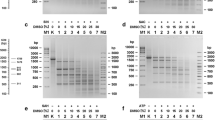Abstract
DNA templates harboring specific single nucleotide polymorphism (SNP) sites are largely needed as positive controls in practical SNP analysis and in determination of the reliability of newly developed methods in high-throughput screening assays. Here we report a one-step method to produce SNP templates by amplifying a wild-type sequence with primers having single nucleotide mismatches at or near their 3′ ends. A short amplicon harboring an EcoRI site was used to evaluate the feasibility of our strategy. Perfectly matched primers and primers with a single base mismatch occurring from the first base to the sixth base of the EcoRI site were used for primer extension. By using polymerase without a proofreading function, we kept mismatched nucleotides from occurring in extended primer products, as confirmed by EcoRI digestion and sequencing analysis. The strategy of using primers with a single mismatched base and exo- polymerase was shown to be an efficient one-step method for preparing SNP templates, either for application in the development of SNP screening assays or as positive controls in practical SNP assays.
Similar content being viewed by others
References
Cargill, M., Altshuler, D., Ireland, J., Sklar, P., Ardlie, K., Patil, N., et al. (1999) Characterization of single-nucleotide polymorphisms in coding regions of human genes. Nature Genet. 22, 231–238.
Halushka, M.K., Fan, J., Bentley, K., Hsie, L., Shen, N., Weder, A., et al. (1999) Patterns of single-nucleotide polymorphisms in candidate genes for blood-pressure homeostasis. Nature Genet. 22, 239–247.
Lindblad-Toh, K., Winchester, E., Daly, M.J. et al. (2000) Large-scale discovery and geotyping of single-nucleotide polymorphisms in the mouse. Nature Genet. 24, 381–386.
Park, S.J., Taton, A., and Mirkin, C.A. (2002) Array-based electrical detection of DNA with nanoparticle probes. Science 295, 1503–1506.
Zhang, J., and Li, K. (2001) The 3′ terminal labeled primer extension: A new method of high throughput screening for SNP analysis. Curr. Drug Discovery 9, 21–24.
Pastinen, T., Raitio, M., Lindroos, K., Tainola, P., Peltonen, L., Syvanen, A.C. (2000) A system for specific, high-throughput genotyping by allele-specific primer extension on microarrays. Genome Res. 10, 1031–1042.
Hill, D.E., Oliphant, A.R., and Struhl, K. (1987) Mutagenesis with degenerate oligonucleotides: An efficient method for saturating a defined DNA region with base pair substitutions. Methods Enzymol. 155, 558–568.
Kunkel, T.A., Roberts, J.D., and Zakour, RA. (1987) Rapid and efficient site-specific mutagenesis without phenotypic selection. Methods Enzymol. 154, 367–382.
Smith, M. (1985) In vitro mutagenesis. Ann. Rev. Genet. 19, 423–467.
Wallace, R.B., Schold, M., Johnson, M.J., et al. (1981) Oligonucleotide directed mutagenesis of the human β-globulin gene: A general method for producing specific point mutations in cloned DNA. Nucl. Acids Res. 9, 3647–3657.
Wells, J.A., Vasser, M., and Poweres, D.B. (1985) Cassette mutagenesis: An efficient method for generation of multiple mutations at defined sites. Gene 34, 315–323.
Huang, M.M., Arnheim, N., and Goodman, M.F. (1992) Extension of base mispairs by TAQ DNA polymerase: implications for single nucleotide discrimination in PCR. Nucl. Acids Res. 20, 4567–4573.
Kwok, D.E., Kellogg, D.E., McKinney, N., Spasic, D., Goda, I., Levenson, C., et al. (1990) Effects of primer-template mismatches on the polymerase chain reaction: human immunodeficiency virus type 1 model studies. Nucl. Acids Res. 18, 995–1005.
Ørum, H., and Wengel, J. (2001) Locked nucleic acids: a promising molecular family for gene-function analysis and antisense drug development. Curr. Opin. Mol. Ther. 3, 239–243.
Martin, G. and Zhang, P. (2000) DNA chips/microarrays and chemistry. Pharmaceuticals 2000 web conference. www.cruachem.co.uk/pages/micro/htm.
Author information
Authors and Affiliations
Corresponding author
Rights and permissions
About this article
Cite this article
Zhang, J., Li, K., Deng, Z. et al. Efficient mutagenesis method for producing the templates of single nucleotide polymorphisms. Mol Biotechnol 24, 105–110 (2003). https://doi.org/10.1385/MB:24:2:105
Issue Date:
DOI: https://doi.org/10.1385/MB:24:2:105



